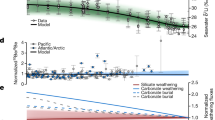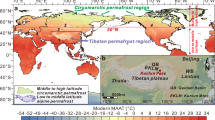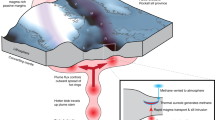Abstract
Between about 55.5 and 52 million years ago, Earth experienced a series of sudden and extreme global warming events (hyperthermals) superimposed on a long-term warming trend1. The first and largest of these events, the Palaeocene–Eocene Thermal Maximum (PETM), is characterized by a massive input of carbon, ocean acidification2 and an increase in global temperature of about 5 °C within a few thousand years3. Although various explanations for the PETM have been proposed4,5,6, a satisfactory model that accounts for the source, magnitude and timing of carbon release at the PETM and successive hyperthermals remains elusive. Here we use a new astronomically calibrated cyclostratigraphic record from central Italy7 to show that the Early Eocene hyperthermals occurred during orbits with a combination of high eccentricity and high obliquity. Corresponding climate–ecosystem–soil simulations accounting for rising concentrations of background greenhouse gases8 and orbital forcing show that the magnitude and timing of the PETM and subsequent hyperthermals can be explained by the orbitally triggered decomposition of soil organic carbon in circum-Arctic and Antarctic terrestrial permafrost. This massive carbon reservoir had the potential to repeatedly release thousands of petagrams (1015 grams) of carbon to the atmosphere–ocean system, once a long-term warming threshold had been reached just before the PETM. Replenishment of permafrost soil carbon stocks following peak warming probably contributed to the rapid recovery from each event9, while providing a sensitive carbon reservoir for the next hyperthermal10. As background temperatures continued to rise following the PETM, the areal extent of permafrost steadily declined, resulting in an incrementally smaller available carbon pool and smaller hyperthermals at each successive orbital forcing maximum. A mechanism linking Earth’s orbital properties with release of soil carbon from permafrost provides a unifying model accounting for the salient features of the hyperthermals.
This is a preview of subscription content, access via your institution
Access options
Subscribe to this journal
Receive 51 print issues and online access
$199.00 per year
only $3.90 per issue
Buy this article
- Purchase on Springer Link
- Instant access to full article PDF
Prices may be subject to local taxes which are calculated during checkout


Similar content being viewed by others
References
Nicolo, M. J., Dickens, G. R., Hollis, C. J. & Zachos, J. Multiple early Eocene hyperthermals: their sedimentary expression on the New Zealand continental margin and in the deep sea. Geology 35, 699–702 (2007)
Zachos, J. C. et al. Rapid acidification of the ocean during the Paleocene–Eocene Thermal Maximum. Science 308, 1611–1615 (2005)
Sluijs, A. et al. Subtropical Arctic Ocean temperatures during the Palaeocene/Eocene thermal maximum. Nature 441, 610–613 (2006)
Higgins, J. A. & Schrag, D. Beyond methane: towards a theory for the Paleocene-Eocene Thermal Maximum. Earth Planet. Sci. Lett. 245, 523–537 (2006)
Kurtz, A. C., Kump, L. R., Arthur, M. A., Zachos, J. C. & Paytan, A. Early Cenozoic decoupling of the global carbon and sulfur cycles. Paleoceanography 18, 1090, http://dx.doi.org/10.1029/2003PA000908 (2003)
Dickens, G. R., O’Neil, J. R., Rea, D. K. & Owen, R. M. Dissociation of oceanic methane hydrate as a cause of the carbon isotope excursion at the end of the Palaeocene. Paleoceanography 10, 965–971 (1995)
Galeotti, S. et al. Orbital chronology of Early Eocene hyperthermals from the Contessa Road section, central Italy. Earth Planet. Sci. Lett. 290, 192–200 (2010)
Beerling, D. J., Fox, A., Stevenson, D. S. & Valdes, P. J. Enhanced chemistry-climate feedbacks in past greenhouse worlds. Proc. Natl Acad. Sci. USA 108, 9770–9775 (2011)
Bowen, G. J. & Zachos, J. Rapid carbon sequestration at the termination of the Palaeocene–Eocene Thermal Maximum. Nature Geosci. 3, 866–869 (2010)
Dickens, J. Rethinking the global carbon cycle with a large, dynamic and microbially mediated gas hydrate capacitor. Earth Planet. Sci. Lett. 213, 169–183 (2003)
Zeebe, R. E., Zachos, J. & Dickens, G. R. Carbon dioxide forcing alone insufficient to explain Palaeocene-Eocene Thermal Maximum warming. Nature Geosci. 2, 576–580 (2009)
Panchuk, K., Ridgwell, A. & Kump, L. R. Sedimentary response to Paleocene-Eocene Thermal Maximum carbon release: a model-data comparison. Geology 36, 315–318 (2008)
Buffett, B. & Archer, D. Global inventory of methane clathrate: sensitivity to changes in the deep ocean. Earth Planet. Sci. Lett. 227, 185–199 (2004)
Kent, D. V. et al. A case for a comet impact trigger for the Paleocene/Eocene thermal maximum and carbon isotope excursion. Earth Planet. Sci. Lett. 211, 13–26 (2003)
Storey, M., Duncan, R. A. & Swisher, C. C., III Paleocene-Eocene Thermal Maximum and the opening of the northeast Atlantic. Science 316, 587–589 (2007)
Cramer, B. S., Wright, J. D., Kent, D. V. & Aubry, M.-P. Orbital climate forcing of δ13C excursions in the late Paleocene–early Eocene (chrons C24n-C25n). Paleoceanography 18, 1097, http://dx.doi.org/10.1029/2003PA000909 (2003)
Lourens, L. et al. Astronomical pacing of late Palaeocene to early Eocene hyperthermal events. Nature 435, 1083–1087 (2005)
Laskar, J. et al. A long-term numerical solution for the insolation quantities of the Earth. Astron. Astrophys. 428, 261–285 (2004)
Westerhold, T., Röhl, U., McCarren, H. K. & Zachos, J. C. Latest on the absolute age of the Paleocene–Eocene Thermal Maximum (PETM): new insights from exact stratigraphic position of key ash layers +19 and −17. Earth Planet. Sci. Lett. 287, 412–419 (2009)
Schuur, E. A. G. et al. Vulnerability of permafrost carbon to climate change: implications for the global carbon cycle. Bioscience 58, 701–714 (2008)
Wilson, D. S. & Luyendyk, B. P. West Antarctic paleotopography estimated at the Eocene-Oligocene climate transition. Geophys. Res. Lett. 36, L16302 (2009)
Tarnocai, C. et al. Soil organic carbon pools in the northern circumpolar permafrost region. Glob. Biogeochem.. Cycles 23, GB2023, http://dx.doi.org/10.1029/2008GB003327 (2009)
Ronov, A., Khain, V. & Balukhovsky, S. Atlas of Lithological-Paleogeographical Maps of the World: Mesozoic and Cenozoic of Continents and Oceans (eds Barsukov, V. L. & Laviorov, N. P. ) (Moscow Editorial Publishing Group VNII Zarubezh-Geologia, Moscow, 1989)
Sloan, L. C., Walker, J. C. G., Moore, T. C., Jr & Rea, D. K. Possible methane-induced polar warming in the early Eocene. Nature 357, 320–322 (1992)
Kalkreuth, W. D. et al. Petrological, palynological and geochemical characteristics of Eureka Sound group coals (Stenkul Fiord, southern Ellesmere Island, Arctic Canada). Int. J. Coal Geol. 30, 151–182 (1996)
Röhl, U., Brinkhuis, H., Sluijs, A. & Fuller, M. in The Cenozoic Southern Ocean: Tectonics, Sedimentation, and Climate Change between Australia and Antarctica (eds Exon, N. F., Malone, M. & Kennett, J. P. ) 113–125 (Geophysical Monograph Series 151, American Geophysical Union, 2004)
Schaefer, K., Zhang, T., Bruhwiler, L. & Barrett, A. P. Amount and timing of permafrost carbon release in response to climate warming. Tellus B 63, 165–180 (2011)
Elberling, B., Christensen, H. H. & Hansen, B. U. High nitrous oxide production from thawing permafrost. Nature Geosci. 3, 332–335 (2010)
Pagani, M., Caldeira, K., Berner, R. & Beerling, D. The role of terrestrial plants in limiting atmospheric CO2 decline over the past 24 million years. Nature 460, 85–88 (2009)
Clymo, R. S. The limits to peat bog growth. Phil. Trans. R. Soc. Lond. B 303, 605–654 (1984)
Zachos, J. C., Dickens, G. R. & Zeebe, R. E. An early Cenozoic perspective on greenhouse warming and carbon-cycle dynamics. Nature 451, 279–283 (2008)
Thompson, S. L. & Pollard, D. Greenland and Antarctic mass balances for present and doubled atmospheric CO2 from the GENESIS Version-2 Global Climate Model. J. Clim. 10, 871–900 (1997)
Kaplan, J. O. et al. Climate change and Arctic ecosystems: 2. Modeling, paleodata-model comparisons, and future projections.. J. Geophys. Res. 108 (D19), 8171, http://dx.doi.org/10.1029/2002JD002559 (2003)
Kiehl, J. T. et al. The National Center for Atmospheric Research Community Climate Model: CCM3. J. Clim. 11, 1131–1149 (1998)
Thompson, S. L. & Pollard, D. A global climate model (GENESIS) with a land-surface-transfer scheme (LSX). Part I: present-day climate. J. Clim. 8, 732–761 (1995)
Zhang, T., Heginbottom, J. A., Barry, R. G. & Brown, J. Further statistics on the distribution of permafrost and ground ice in the northern hemisphere. Polar Geogr. 24, 126–131 (2000)
Sewall, J. O., Sloan, L. C., Huber, M. & Wing, S. Climate sensitivity to changes in land surface characteristics. Glob. Planet. Change 26, 445–465 (2000)
Pagani, M., Caldeira, K., Archer, D. E. & Zachos, J. An ancient carbon mystery. Science 314, 1556–1557 (2006)
Ramaswamy, V. et al. in Climate Change 2001: The Scientific Basis (eds Haughton, J. T. et al.) 351–416 (Cambridge Univ. Press, 2001)
Shi, G. Radiative forcing and greenhouse effect due to the atmospheric trace gasses. Sci. China B 35, 217–229 (1992)
Beerling, D., Berner, R. A., Mackenzie, F. T., Harfoot, M. B. & Pyle, J. A. Methane and the CH4-related greenhouse effect over the past 400 million years. Am. J. Sci. 309, 97–113 (2009)
Dutta, K., Schuur, E. A. G., Neff, J. C. & Zimov, S. A. Potential carbon release from permafrost soils of Northeastern Siberia. Glob. Change Biol. 12, 2336–2351 (2006)
Khvorostyanov, D. V., Ciais, P., Krinner, G. & Zimov, S. A. Vulnerability of east Siberia’s frozen carbon stores to future warming. Geophys. Res. Lett. 35, L10703, http://dx.doi.org/10.1029/2008GL033639 (2008)
Zech, M. et al. Characterization and palaeoclimate of a loess-like permafrost palaeosol sequence in NE Siberia. Geoderma 143, 281–295 (2008)
Price, J. S., Cagampan, J. & Kellner, E. Assessment of peat compressibility: is there an easy way? Hydrol. Process. 19, 3469–3475 (2005)
Schuur, E. A. G. et al. The effect of permafrost thaw on old carbon release and net carbon exchange from tundra. Nature 459, 556–559 (2009)
Acknowledgements
This work was funded by the US National Science Foundation under award ATM-0513402/0513421 to R.M.D. and D.P., and EAR-0628358 to M.P. D.J.B. acknowledges support from a Royal Society-Wolfson Research Merit Award.
Author information
Authors and Affiliations
Contributions
R.M.D. conceived the permafrost–hyperthermal model with input from S.G., M.P., D.T., D.P. and D.J.B. S.G. developed the cyclostratigraphic framework and performed MTM and SSA analyses. R.M.D., D.T. and D.P. designed the numerical modelling scheme and D.T. analysed the GCM results. D.J.B. and R.M.D. developed the changing GHG concentration scenarios for the model simulations. K.S. and T.Z. refined the carbon calculations. R.M.D. was the primary author and all co-authors contributed to the writing and response to reviewers.
Corresponding author
Ethics declarations
Competing interests
The authors declare no competing financial interests.
Supplementary information
Supplementary Information
This file contains Supplementary Methods, Supplementary Figures 1-13, Supplementary Table 1 and additional references. This file was replaced on 22 August 2012, as Supplementary Table 1 contained incorrect data – see the corrigendum 11424 linked to the this paper for details. (PDF 4161 kb)
PowerPoint slides
Rights and permissions
About this article
Cite this article
DeConto, R., Galeotti, S., Pagani, M. et al. Past extreme warming events linked to massive carbon release from thawing permafrost. Nature 484, 87–91 (2012). https://doi.org/10.1038/nature10929
Received:
Accepted:
Published:
Issue Date:
DOI: https://doi.org/10.1038/nature10929
This article is cited by
-
The fusion of multiple scale data indicates that the carbon sink function of the Qinghai-Tibet Plateau is substantial
Carbon Balance and Management (2023)
-
Benthic foraminiferal turnover and trait changes across the Palaeocene–Eocene Thermal Maximum (PETM) at ODP site 1265A, Walvis Ridge, SE Atlantic Ocean
Arabian Journal of Geosciences (2023)
-
Astrochronology of the Paleocene-Eocene Thermal Maximum on the Atlantic Coastal Plain
Nature Communications (2022)
-
Warm deep-sea temperatures across Eocene Thermal Maximum 2 from clumped isotope thermometry
Communications Earth & Environment (2022)
-
Paleocene/Eocene carbon feedbacks triggered by volcanic activity
Nature Communications (2021)
Comments
By submitting a comment you agree to abide by our Terms and Community Guidelines. If you find something abusive or that does not comply with our terms or guidelines please flag it as inappropriate.



